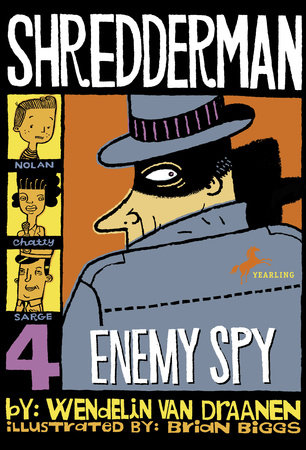TEACHING GUIDE
NOTE TO TEACHERSNolan Byrd is a great kid who feels “invisible.”
With no friends and a bully named Bubba
constantly hounding him, school isn’t an easy
place to be. It’s a good thing that Nolan has
terrific parents who support him, and a cool
teacher who inspires him. Fed up with Bubba
and his bullying ways, Nolan creates a Web site
for his alter ego, cyber-superhero Shredderman.
As Shredderman, Nolan exposes Bubba the
bully, and along the way, discovers that the
fight for truth and justice is bigger and more
important than his own problems.
ABOUT THIS BOOKSince putting the tabloid photographer Joel “The Mole” Bowl out of business,
Shredderman is a national sensation. Can Nolan keep Shredderman online long
enough to uncover an international spy ring in Cedar Valley?
ABOUT THIS AUTHORGrowing up,
Wendelin Van
Draanen was a
tomboy who loved
to be outside chasing
down adventure. She
did not decide that
she wanted to be an
author until she was
an adult. When she
tried her hand at writing a screenplay about a family
tragedy, she found the process quite cathartic, and
from that experience, turned to writing novels for adults.
She soon stumbled upon the joys of writing for children.
Van Draanen lives with her husband and two sons in
California.
Q. What inspired you to write the Shredderman
series?
A. A confluence of several things: having been
bullied as a child; seeing my oldest son ostracized at
school; being a computer science teacher; and observing
that kids find ways to bully other kids.
I wanted to create something fun, fast-paced,
and substantive that would help spark a love
of reading.
Q. What do you like best about your character
Nolan Byrd?
A. That he’s a champion of the underdog. He’s undaunted,
creative, enthusiastic, and is such
a sweet kid.
Q. What has been the best compliment you’ve ever
received from a child about the Shredderman
series?
A. The most touching comment came from a shy fourthgrade
boy who approached me after a school visit and
whispered, “I wish Shredderman went to our school.”
I leaned forward and whispered back, “He does.”
Then I tapped him on the chest and said, “He’s right
inside. You just have to let him out.”
DISCUSSION AND WRITING1. Discuss what Nolan means when
he says, “It’s funny how missing
words can be so much louder than
real words.” (p. 17)
2. Discuss a time when you felt so
mad or upset that you needed to be
alone. Do you think Nolan was wise
to ride so far from home? What else
could he have done to feel better?
3. After Nolan’s dad comes to school
and discovers him eating lunch
alone, why does Nolan feel worse
about having no friends? Why do you
think such a smart, nice kid doesn’t
have any friends?
4. Nolan confronts the TV reporter
Harry Kane in an attempt to help his
parents. How has being
Shredderman given Nolan the
courage to stand up for what is right?
Do you think Nolan made the right
decision in revealing that he is
Shredderman? Explain.
SUGGESTED ACTIVITIES1. On page 49, Nolan says, “Maybe
Benjamin Franklin was never a
United States president, but he
definitely deserves to be on the
one-hundred-dollar bill.” Research
the life and contributions of this
extraordinary founding father of
the United States.
2. Nolan loves words and knows
a lot
of them. He’s fond of coming up with
synonyms for words, such as
unkempt,
slovenly, and
bedraggled.
(p. 52) Instruct students on how to
use a thesaurus to find synonyms for
common words. Have students make
a booklet with 25 words and at least
three synonyms for each word.
Students can illustrate each page
with original artwork.
3. Have students write an epilogue
to the Shredderman series.
VOCABULARYVigilantism (p. 2),
speculation (p. 4)
, tactics (p. 5), powwow (p. 11),
conspicuous (p. 11),
conventional
(p. 13),
sinister (p. 39),
classified (p. 56),
mirage (p. 60)
, cryptic (p. 107), and
copasetic (p. 149).

